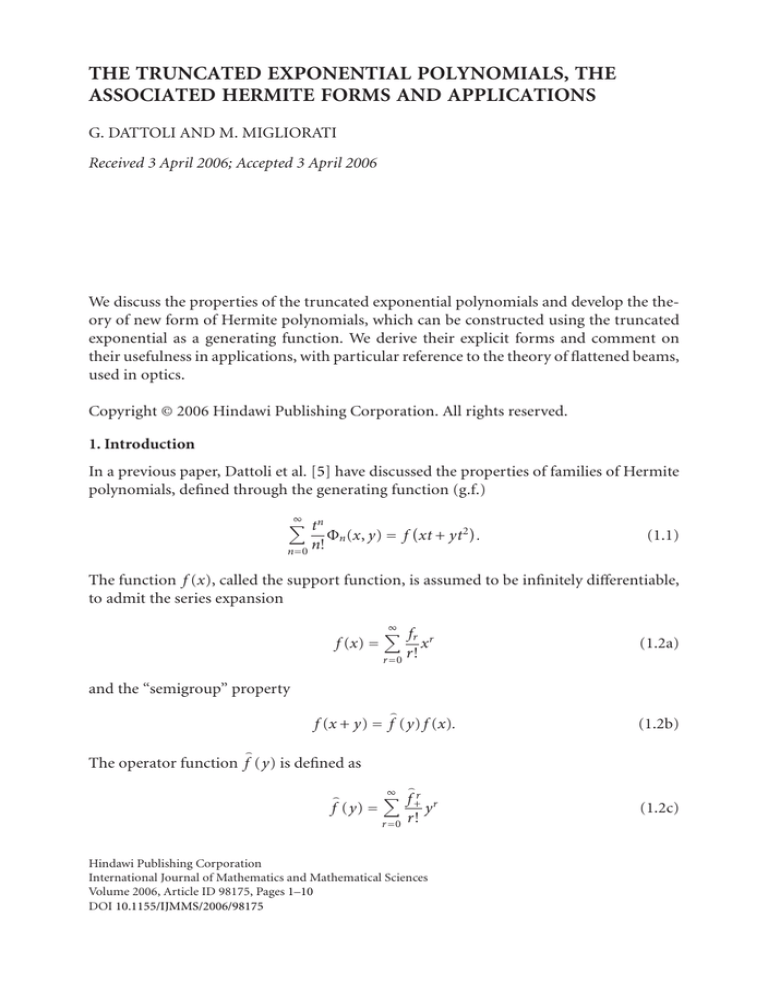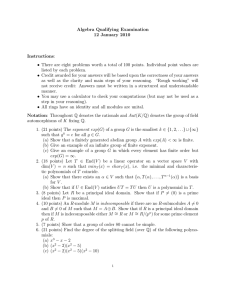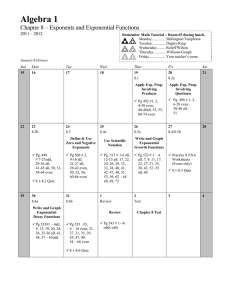
THE TRUNCATED EXPONENTIAL POLYNOMIALS, THE
ASSOCIATED HERMITE FORMS AND APPLICATIONS
G. DATTOLI AND M. MIGLIORATI
Received 3 April 2006; Accepted 3 April 2006
We discuss the properties of the truncated exponential polynomials and develop the theory of new form of Hermite polynomials, which can be constructed using the truncated
exponential as a generating function. We derive their explicit forms and comment on
their usefulness in applications, with particular reference to the theory of flattened beams,
used in optics.
Copyright © 2006 Hindawi Publishing Corporation. All rights reserved.
1. Introduction
In a previous paper, Dattoli et al. [5] have discussed the properties of families of Hermite
polynomials, defined through the generating function (g.f.)
∞ n
t
n =0
n!
Φn (x, y) = f xt + yt 2 .
(1.1)
The function f (x), called the support function, is assumed to be infinitely differentiable,
to admit the series expansion
f (x) =
∞
fr
r =0
r!
xr
(1.2a)
and the “semigroup” property
f (x + y) = f (y) f (x).
(1.2b)
The operator function f (y) is defined as
f (y) =
∞
f +r
r =0
r!
yr
Hindawi Publishing Corporation
International Journal of Mathematics and Mathematical Sciences
Volume 2006, Article ID 98175, Pages 1–10
DOI 10.1155/IJMMS/2006/98175
(1.2c)
2
Truncated exponential polynomials
with f +r acting on fs in such a way that
f +r fs
= fs+r .
(1.2d)
Under these assumptions, the polynomials Φn (x, y) can explicitly be written as
Φn (x, y) = n!
[n/2]
r =0
fn−r xn−2r y r
.
(n − 2r)!r!
(1.3)
In this paper, we will discuss a particular case of the polynomials (1.3), having as support
the polynomials of the truncated exponential (TEP), namely,
∞ n
t
n!
n =0
Hn x, y | m = em (xt + yt 2 ),
(1.4)
where
em (x) =
m r
x
r =0
r!
,
(1.5)
are the PTE, according to the definition of [1]. The reason of the interest for this family of
polynomials stems from the fact that they currently appear in the theory of the so-called
flattened beams, which plays a role of paramount importance in optics and in particular
in the case of super-Gaussian optical resonators (see, e.g., [6]).
A comprehensive theory of the TEP has been developed in [4], where different generalizations have been proposed and we will take some advantages from that general treatment.
The PTE can also be defined by means of the g.f.
∞
t n en (x) =
n =0
exp(xt)
,
1−t
|t | < 1,
(1.6a)
satisfying the recurrences
d
en (x) = en−1 (x),
dx
x
d
en+1 (x) = 1 +
1−
en (x)
n+1
dx
(1.6b)
which can be combined to obtain the relevant second-order differential equation [1]
xen − (n + x)en + nen = 0.
(1.7)
For future convenience, we will write the PTE in the form
en (x) =
∞
θ(n − r)
r =0
r!
xr ,
(1.8)
G. Dattoli and M. Migliorati 3
where θ(x) denotes the Heaviside step function, defined in such a way that
⎧
⎨1,
x ≥ 0,
x < 0.
θ(x) = ⎩
0,
(1.9)
By comparing (1.2) and (1.8), it is evident that in the case of PET fr = θ(n − r). We can
therefore obtain the explicit form of the Hermite polynomials of the truncated exponential (THP), as it will be shown in the forthcoming section.
2. Hermite polynomials of the truncated exponential
According to the previous discussion, the THP can explicitly be written as
Hn x, y | m = n!
[n/2]
r =0
θ m − (n − r) xn−2r y r
(n − 2r)!r!
(2.1)
and we can use (1.5) and (1.6) to establish the relevant recurrences. By keeping the derivatives of both sides of (1.5) with respect to x, y, t, we obtain three recurrences, involving
the continuous variables and the discrete indices, namely,
∂
Hn (x, y | m) = nHn−1 (x, y | m − 1),
∂x
∂
Hn (x, y | m) = n(n − 1)Hn−2 (x, y | m − 1),
∂y
Hn+1 (x, y | m) = xHn (x, y | m − 1) + 2ynHn−1 (x, ym − 1 .
(2.2)
We can combine the first two recurrences to infer that the HPTE satisfy the “heat” type
equation
∂2
∂
F(x, y) = f + 2 F(x, y),
∂y
∂x
F(x,0) = θ(m − n)xn ,
(2.3)
where f + is an operator, defined in such a way that
r
f ± θ(m) = θ(m ± r).
(2.4)
(A kind of ambiguity seems to arise in the definition of the operators f ± . Strictly
speaking,
according to the definition given in the previous section, we should have f ±r θ(m − n) =
θ(m − (n ± r)) and the operator should therefore act on the indices where the summation series is running. We prefer, for practical reasons, the definition given
in (2.4),
which
induces discrete variations on the index m; it is however evident that f ± = f ∓ .) We can
handle (2.3) to obtain the following operational definition for the TEP: a proper combination of the last recurrence in (2.2) with the first yielding the identity
Hn+1 (x, y | m) = Mm Hn (x, y | m),
Mm = x f − + 2y
∂
,
∂x
(2.5)
4
Truncated exponential polynomials
which, together with the first recurrence of (2.2), leads to the following second-order
differential equation (see [5]):
x f−
∂
∂2
Hn (x, y | m) + 2y 2 Hn (x, y | m) − n f − Hn (x, y | m) = 0.
∂x
∂x
(2.6)
(According to the formalism of monomiality (see [4]), we can define a multiplicative
operator (in this case provided by Mm) and a derivative operator P = ∂/∂x; the THPs are
easily seen to satisfy the identity Mm P Hn (x, y | m) = nHn (x, y | m), which yields (2.6).)
Needless to say, all the previous relations reduce to those of the ordinary Hermite for
1
y=− ,
2
fn = 1.
(2.7)
( Note that Hn (x, −1/2) can be identified with the polynomials Hen (x), defined by the
generating function exp(xt − t 2 /2).) Let us now consider the problem of finding a simple
formula yielding the successive derivatives, with respect to t, of the right-hand side of
(1.5). Using the previous definitions, we get
∂p em xt + yt 2 = H p (x + 2yt, y | m)em xt + yt 2 ,
∂t p
(2.8)
where H(x, y | m) should be understood as an operator, defined as follows:
Hn x, y | m = n!
[n/2]
f n−r xn−2r y r
−
r =0
(n − 2r)!r!
.
(2.9)
The proof of the previous relations can be achieved in a fairly direct way. By multiplying,
indeed, the right-hand side of (2.8) by ξ p / p! and then summing over p, we get
∞
ξ p ∂p
p =0
p! ∂t
e xt + yt 2 = exp ξ
p m
∂
em xt + yt 2
∂t
2
2
(2.10)
= em xt + yt + (x + 2yt)ξ + ξ ,
and thus, using the semigroup property (1.2b), we easily end up with (2.8). In alternative,
(2.8) can also be written as
p/2
(x + 2yt) p−2r y r
∂p 2
e
xt
+
yt
p!
em− p−r xt + yt 2 .
=
m
∂t p
(p
−
2r)!r!
r =0
(2.11)
The results obtained in this section provide the backbone of the topics we will discuss in
the forthcoming sections.
3. Some applications of TEP and THP
The flattened beams have been introduced in [6] to study optical systems employing the
so-called super-Gaussian beams, namely, optical beams whose transverse shape is not
G. Dattoli and M. Migliorati 5
reproduced by a simple Gaussian, but by a function exhibiting a quasi constant flat top
as, for example,
S(x, p) = exp − |x| p ,
p > 2.
(3.1)
Unlike the ordinary Gaussian beams, the super-Gaussians do not have transparent propagation properties, which can easily be exploited in the design of an optical resonator.
The flattened beams defined as
F(x,m) = em x2 exp − x2
(3.2)
provide a good tool of approximation of a super-Gaussian, and their paraxial evolution
can be treated using straightforward analytical tools.
A super-Gaussian can be reproduced according to the relation S(x, p) ∼
= F(ax,m), with
a,m conveniently chosen in correspondence of the order p of the super-Gaussian. An example is shown in Figure 3.1, where we have made the comparison between F(4.76x,20)
and a super-Gaussian of order p = 10.
In Figure 3.2, we also report a comparison between a flattened beam function (FBF)
and an ordinary Gaussian.
A first useful information characterizing the FBF can be obtained by deriving the differential equation they satisfy. By noting indeed that
em (x2 ) = exp x2 F(x,m),
(3.3)
we find from (1.7) that
2
T m exp x2 F(x,m) = 0,
d
Tm = ξ
dξ
d
+ m,
dξ
(3.4)
1 F (x,m) = 0.
2
(3.5)
− (m + ξ)
ξ = x2 ,
which explicitly yield the fairly simple form
xF (x,m) + 2 x2 − m −
The use of the rules which we have established in Section 2 allows the derivation of a
simple formula yielding the successive derivatives of the FBF. By noting indeed that
d
dx
s
em x2 = Hs (2x,1 | m)em x2 = s!
[s/2]
r =0
(2x)s−2r
em−s−r x2
(s − 2r)!r!
(3.6)
and that
d
dx
s
exp − x2 = (−1)s Hs (2x, −1)exp − x2
(3.7)
6
Truncated exponential polynomials
1
0.5
0
−3
−2
−1
0
x
1
2
3
Super-Gaussian
Flattened beam function
Figure 3.1. Comparison between a super-Gaussian with p = 10 (dotted curve) and a flattened beam
function F(bx,m), b = 4.76, m = 20 (solid curve); the two curves are undistinguishable.
1
0.5
0
−10
−5
0
x
5
10
Flattened beam function, m = 8
Flattened beam function, m = 4
Gaussian
Figure 3.2. Flattened beam (dotted: m = 8, continuous: m = 4) and Gaussian (dashed).
r
n−2r /(n − 2r)!r!) are the ordinary
(note that Hn (2x, −1) = Hn (x) = n! [n/2]
r =0 ((−1) (2x)
2
Hermite defined by the g.f. exp(2xt − t )), we obtain
d
dx
p
F(x,m) =
p p
r =0
r
(−1)r H p−r (2x,1 | m)Hr (2x, −1)F(x,m).
(3.8)
Let us now discuss how the above formalism can be exploited to treat problems associated with the propagation of an FBF.
G. Dattoli and M. Migliorati 7
We therefore consider the following heat-type equation:
∂2
∂
Y (x,t) = 2 Y (x,t),
∂t
∂x
(3.9)
Y (x,0) = F(x,m),
whose formal solution can be written as
∂
Y (x,t) = exp t
∂x
2 F(x,m).
(3.10)
To get an explicit solution, we should recall some rules of operational nature.
The use of the well-known identity
∂2 ∂2
∂2
∂2
exp b 2 xn g(x) = exp b 2 xn exp − b 2 exp b 2 g(x)
∂x
∂x
∂x
∂x
∂
= x + 2b
∂x
n
(3.11)
∂2
exp b 2 g(x)
∂x
yields
∂
exp t
∂x
2 F(x,m) =
2r
x + (2t)∂/∂x
m
∂
exp t
∂x
r!
r =0
2 exp − x2 ;
(3.12)
making therefore a combined use of the modified Burchnall formula (see, e.g., [3])
∂
x + 2b
∂x
n
=
n
2b
r n
r =0
r
Hn−r (x,b)
∂
∂x
r
(3.13)
of the identity (some times referred to as the Gleisher operational rule (see [8]))
exp t
∂
∂x
2 exp − x2 = √
1
x2
exp −
1 + 4t
1 + 4t
(3.14)
and of the following properties of the Hermite polynomials:
n n
s =0
s
an Hn (x, y) = Hn ax,a2 y ,
Hn−s (x, y)Hs (x , y ) = Hn (x + x , y + y ),
∂
∂x
n
(3.15)
exp ax2 = Hn (2ax,a)exp ax2 ,
we end up with
1
x
x2
t
Y (x,t) = √
Ωm
| 2 exp −
,
,
1 + 4t 1 + 4t
1 + 4t
1 + 4t
(3.16)
8
Truncated exponential polynomials
1
0.5
0
−20
−10
0
x
10
20
t=2
t=0
t=8
Figure 3.3. FBF evolution m = 8 at different times (continuous: t = 0; dotted: t = 2; dashed: t = 8).
where we have defined
Ωm (x, y | p) =
m
H pr (x, y)
r =0
(3.17)
r!
which is a Hermite-based polynomial of the truncated exponential, whose properties have
been studied in [4]. An example of evolution at different times of the Y (x,t) function is
given in Figure 3.3.
Analogous results can be obtained for the case of the free paraxial (Schrödinger) equation
i
∂2
∂
Y (x,t) = − 2 Y (x,t),
∂t
∂x
Y (x,0) = F(x,m)
(3.18)
whose solution is omitted for the sake of conciseness.
4. Concluding remarks
Before closing the paper, let us add some comments aimed at better framing the obtained
results.
We therefore go back to the definition of FBF and consider the evaluation of average
quantities like
x
p
=
∞
−∞
x p F(x,m)dx.
(4.1)
To perform such a calculation, we consider the following integral:
Σ p,m (a,b,c) =
∞
−∞
x p Hn (ax,by)exp − cx2 dx.
(4.2)
G. Dattoli and M. Migliorati 9
The explicit evaluation of this integral can be done using the generating function method
(1.7), thus we get
Σ p,m (a,b,c) =
a2 + 4bcy
π
1 a
,
Hm,p 0,
;0, |
c
4c
4c 2c
(4.3)
where
Hm,n (x, y;z,w | ζ) = m!n!
[m,n]
ζrH
m−r (x, y)Hn−r (z,w)
r!(n − r)!(m − r)!
r =0
(4.4)
are two index Hermite polynomials (see [2, 3]). It is easily checked that in the case of (4.3)
the odd indices are zero. It is therefore evident that the FBF root mean square at different
times can be written as
2
x
=
m
√ H2r,2 0,(x2 + 4t)/4(1 + 4t);0,(1 + 4t)/4 | x/2
π
(r)!
r =0
(4.5)
which can be exploited to study the behavior of transverse section of a flattened beam.
The function
g(x,m) = em − x2
(4.6)
can be considered a kind of truncated Gaussian and can be exploited in the theory of
approximation; it shares interesting properties with the ordinary Gaussian and indeed
we get
(−1)s
d
dx
s
em − x2 = Hs (2x, −1 | m)em − x2
(4.7)
and also the Gleisher type formula
∂
exp t
∂x
2 em − x2 = H em − x2 ,t ,
(4.8)
where
H en (−x
2
, y) =
n
(−1)r
r =0
r!
H2r (x, y).
(4.9)
We have stressed that the use of FBF simplifies the problems associated with the evaluation of beam transport, which in the case of super-Gaussian beams should be evaluated
numerically. We have shown that analytical solutions can be obtained using operational
methods and the properties of the TEP. Different methods can however be adopted. As
also indicated in [6], the use of the expansion of the TEP in terms of Laguerre polynomials allows the use of the properties of Laguerre-Gauss optical beams, whose propagation
properties are well documented in the literature (see [7]) and the method we have proposed is just an alternative to this early suggestion.
10
Truncated exponential polynomials
The properties of the THPE and of their applications go far beyond the topics we have
discussed in this paper. In forthcoming investigations, we will extend the present analysis
and discuss the importance of THPE in combinatorics.
References
[1] L. C. Andrews, Special Functions for Engineers and Applied Mathematicians, Macmillan, New
York, 1985.
[2] P. Appell and J. Kampé de Fériet, Fonctions hypérgeométriques et Hypérspheriques; polinòmes
d’Hermite, Gauthier-Villars, Paris, 1926.
[3] G. Dattoli, Hermite-Bessel and Laguerre-Bessel functions: a by-product of the monomiality principle, Advanced Special Functions and Applications (Melfi, 1999) (D. Cocolicchio, G. Dattoli, and
H. M. Srivastava, eds.), Proc. Melfi Sch. Adv. Top. Math. Phys., vol. 1, Aracne, Rome, 2000, pp.
147–164.
[4] G. Dattoli, C. Cesarano, and D. Sacchetti, A note on truncated polynomials, Applied Mathematics
and Computation 134 (2003), no. 2-3, 595–605.
[5] G. Dattoli, H. M. Srivastava, and D. Sacchetti, The Hermite polynomials and the Bessel functions
from a general point of view, International Journal of Mathematics and Mathematical Sciences
2003 (2003), no. 57, 3633–3642.
[6] F. Gori, Flattened Gaussian beams, Optics Communications 107 (1994), no. 5-6, 335–341.
[7] A. Siegman, Lasers, University Science Books, California, 1986.
[8] H. M. Srivastava and H. L. Manocha, A Treatise on Generatine Functions, Ellis-Horwood Series:
Mathematics and Its Applications, John Wiley & Sons, New York, 1984.
G. Dattoli: ENEA, UTS Tecnologie Fisiche Avanzate, Centro Ricerche Frascati,
Via Enrico Fermi 45, 00044 Frascati, Rome, Italy
E-mail address: dattoli@frascati.enea.it
M. Migliorati: Dipartimento di Energetica, Università degli Studi di Rome “La Sapienza,”
14 Via A. Scarfa, 00161 Rome, Italy
E-mail address: mauro.migliorati@uniroma1.it







